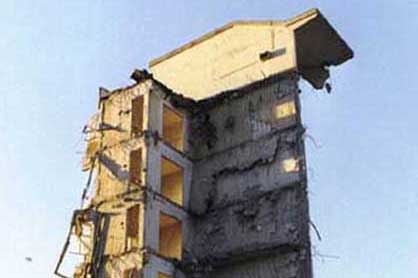|
|
||||||
| image | activities | contacts | links | italiano | ||||||
|
5th
International Festival for Architecture in Video |
||||||
|
introduction program - dates - authors - works - exhibitions partners credits previous editions mailto |
 Alessandro Bagella Apparent radicalism Italy 2000, 1’30” The emotional involvement caused by the explosion of a residential building may lead to different, or even opposite reactions. In any case, one can watch the event only if he/she, as a passive onlooker, has accepted to endure the event. In the United States, demolition is a town planning device that has been in use for quite a while. The planning of a demolition actually changes the possible tragic aspect into collective enthusiasm, which is then made sublime by the spectacular effects of the final explosion. In Italy, on the other hand, demolition equals remedy, that is making up for building abuses, landscape destruction and social disasters, for example the case of the “Vele” (the Sails) of Scampia in Naples. Research in the field of public housing is yet unable to overcome serial and modular repetition as a principle for every architectural and town planning project. In a similar framework the “Vele” are different from other buildings form the point of view of typology, aesthetics, composition and structure and, therefore, have an important role in the history of Italian contemporary architecture. The economic problems connected to the difficult yet necessary restructuring of the “Vele” have led to the idea of demolition and reconstruction. Indeed, this is exactly the opposite treatment used for all other monuments. In any case demolition of the “Vele” will lead to very little contribution to the development of this suburb, because eliminating apparent decay does not mean substituting the dominating mentality! It is impossible to change widespread and well-established behaviour and leave the people living in the area aside from the on-going environmental changes. It is deceptive to believe that this can be done in a split second. Children are the only ones who can really change things, change the future which lies in their hands, even though it seems to lie in our heads. Alessandro Bagella was born in Arezzo (Italy) in 1970. Student of Architecture at the University of Florence, spent the last year in Naples, living nearby the site of work. His final thesis, "Catalytic borders", inquires into potentials and contradictions of infrastructures: dynamic perception of space and functional conversion of underviaducts being the main topics of the project. In 1998 was selected for the international workshops organised by the "Netherlands Architecture Institute" (Rotterdam) and "the Berlage Institute (Amsterdam), held by Lebbeus Woods and Steven Holl respectively; the former ended up with a collective exhibition at the NAI and the publication by NAI publisher. During the "VII seminar on architecture and urban culture" (Camerino, 1997), presented the project "Vertical squares", a public space meant to be freely modifiable by anyone (published on "Metamorfosi" n°38, 1998). |
VIDEO | ||||